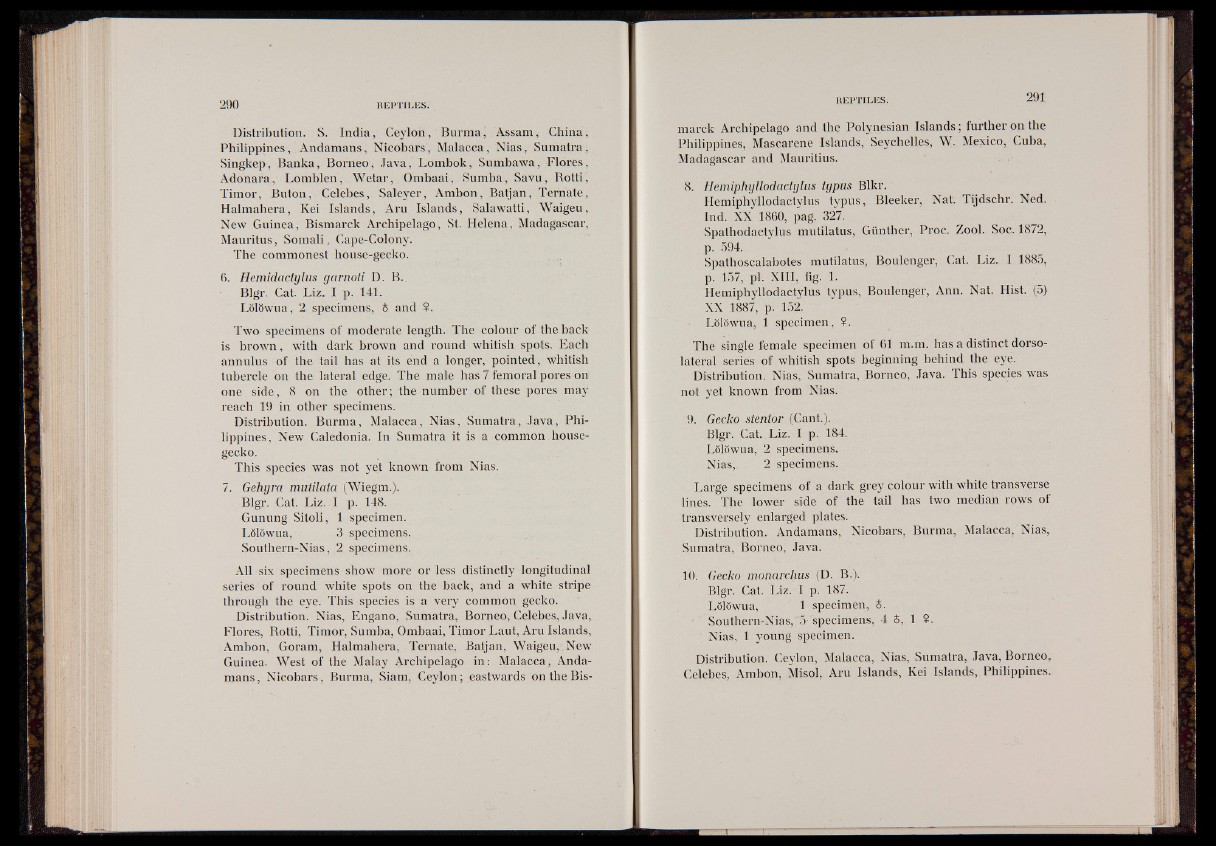
Distribution. S. In d ia , Ceylon, Burmaj Assam, China,
P hilippines, A n d am an s, Nicobars, Malacca, Nias, Sumatra;
Singkep, Banka, Borneo, Jav a , Lombok, Sumbawa, Flores,
Adonara, Lomblen, W e ta r, Ombaai, Sumba, Savu, Rotti,
Timor, Buton, Celebes, Saleyer, Ambon, Batjan, Ternate,
Halmahera, Kei Islands, Aru Islands, Salawatti, Waigeu,
New Guinea, Bismarck Archipelago, St. Helena, Madagascar,
Mauritus, S om a li, Cape-Colony.
The commonest house-gecko.
6. H e m i d a c t y l u s g a r n o t i D. B.
Blgr. Cat. Liz, I p. 141.
Lolowua, 2 specimens, S and ?.
Two specimens of moderate length. The colour of the back
is b row n , with dark brown and round whitish spots. Each
annulus of the tail has at its end a longer, pointed, whitish
tubercle on the lateral edge. The male has 7 femoral pores on
one side, 8 on the other; the number of these pores may
reach 19 in other specimens.
Distribution. B u rm a , Malacca, Nias, S umatra, Java , Philippines,
New Caledonia. In Sumatra it is a common house-
gecko.
This species was not yet known from Nias.
7. G e h y r a m u t i l a t a (Wiegm.j. •
Blgr. Cat. Liz. I p. 148.
Gunung Sitoli, 1 specimen.
L61owua, 3 specimens.
Southern-Nias, 2 specimens.
All six specimens show more or less distinctly longitudinal
series of round white spots on the back, and a white stripe
through the eye. This species is a very common gecko.
Distribution. Nias, Engano, Sumatra, Borneo, Celebes, Java,
Flores, Rotti, Timor, Sumba, Ombaai, Timor Laut, Aru Islands,
Ambon, Goram, Halmahera, Ternate, Batjan, Waigeu, New
Guinea. West of the Malay Archipelago in: Malacca, Andamans
, Nicoba rs, Burma, Siam, Ceylon; eastwards on the Bismarck
Archipelago and the Polynesian Is lan d s ; further on the
Philippines, Mascarene Islands, Seychelles, W- Mexico, Cuba,
Madagascar and Mauritius.
8. H e m i p h y l l o d a c l y l u s t y p u s Blkr.
Hemiphyllodactylus typus, Bleeker, Nat. Tijdschr. Ned.
Ind. XX 1860, pag. 327.
Spathodactylus mutilatus, Gunther, Proc. Zool. Soc. 1872,
p. 594.
Spathoscalabotes mutilatus, Boulenger, Cat. Liz. I 1885,
p. 157, pi. XIII, fig. 1.
Hemiphyllodactylus typus, Boulenger, Ann. Nat. Hist. (5)
XX 1887, p. 152.
Lolowua, 1 specimen, ?.
The single female specimen of 61 m.m. has a distinct dorsolateral
series of whitish spots beginning behind the eye.
Distribution. Nias, Sumatra, Borneo, Java. This species was
not yet known from Nias.
9. G e c k o s t e n t o r (Cant.).
Blgr. Cat. Liz. I p. 184.
Lolowua, 2 specimens.
Nias, 2 specimens.
Large specimens of a dark grey colour w ith white transverse
lines. The lower side of the tail has two median rows of
transversely enlarged plates.
Distribution. Andamans, Nicobars, Burma, Malacca, Nias,
Sumatra, Borneo, Java.
10. G e c k o m o n a r c h u s (D. B.).'
Blgr. Cat. Liz. I p. 187.
Lolowua, 1 specimen, A
Southern-Nias, 5 specimens, 4 S, 1 ?.
Nias, 1 young specimen.
Distribution. Ceylon, Malacca, Nias, Sumatra, Java, Borneo,
Celebes, Ambon, Misol, Aru Islands, Kei Islands, Philippines.